With Noirember right around the corner we thought we’d give you a list of movies to watch in celebration. If you couldn’t tell from our previous articles, we love film noir. And we love talking about our love of film noir almost as much as we love watching them. So here’s a list of some great movies to use as a primer for the Film Noir genre if you’re just discovering these old gems. If you’re familiar with the genre there’s a couple deep cuts in here for you too.
We’re starting the list with a Halloween-esque Horror Noir and ending with a Christmas one because with 40+ films, this list will take you til Christmas. This list is not in any particular order other than the holiday bookends. That said, Touch of Evil is usually considered the end of the noir era. So, you can end with that if you wish.
Also, a lot of these are based on books. Like always, we post links to Amazon where we get a very small commission. We love the commission but we love independent booksellers more, buy from them if you can. Bezos has enough money.
The Seventh Victim (1943)
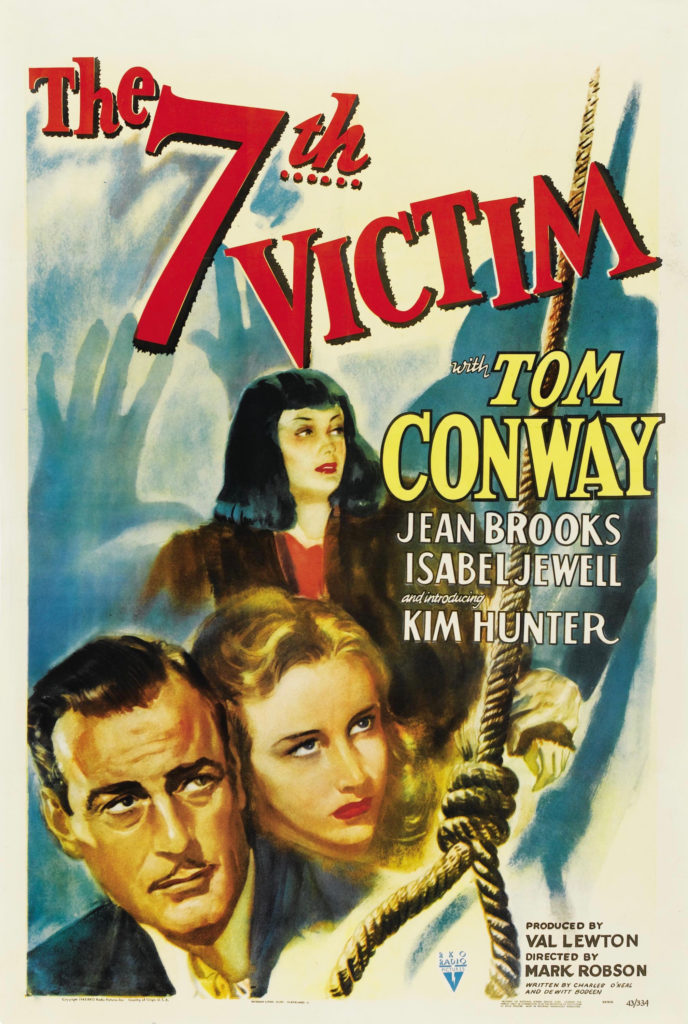
Considered by some as half noir, half gothic-horror, this RKO picture is about a young woman named Mary Gibson (Kim Hunter) who runs into a satanic cult in Greenwich Village while looking for her missing sister Jacqueline Gibson (Jean Brooks).
There’s a shower scene that has been considered an influence on Alfred Hitchcock’s famous shower scene in Psycho (1960). It’s not as iconic, look and compare for yourself.
They Live By Night (1948)
Based on the novel Thieves Like Us by Edward Anderson. This movie was a huge influence for Quentin Tarantino when he penned, True Romance. It’s awesome, you’re watching this couple get their teeth kicked in every step of the way.

Farley Granger plays “Bowie” Bowers, a kid wrongly convicted of murder who breaks out of prison with two other inmates played by Howard da Silva and Jay C. Flippen.
While he’s on the lam, Bowie meets one of the criminal’s niece, Keechie played by Cathy O’Donnell. They quickly fall in love. Bowie wants to lawyer up and clear his name but he doesn’t have the funds. Luckily the career criminals have a heist plan which he helps them out with. Now he’s an actual criminal and well, it get’s ugly from there. The couple keeps getting screwed over by their lawless acquaintances.
This is a classic film noir where one bad decision after another makes the characters way worse off than before. Also, when Tom Waits says “He kind of looked like Farley Granger, with his hair slicked back” in the noir song Burma Shave, he’s referencing this movie.
99 River Street (1953)
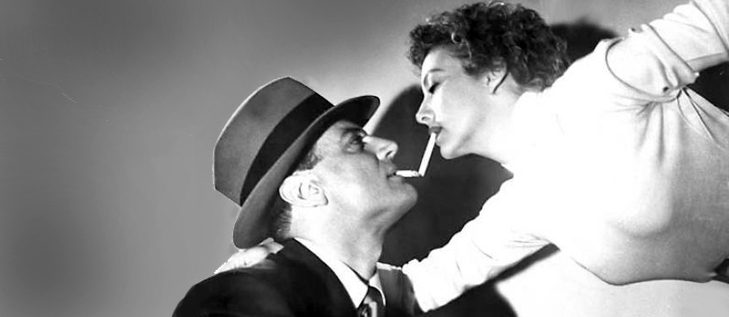
I caught 99 River Street on Noir Alley with Eddie Muller and really enjoyed it. It’s based on the short story Crosstown by George Zuckerman which appeared in the October 1945 issue of Cosmopolitan. Yeah. Cosmo. But don’t let that deter you, it’s a good movie.
The movie starts in the ring of a heavyweight bout, from Ernie Driscoll’s cornerman’s POV (point of view). Ernie, played by John Payne get’s his ass kicked.
We then see Ernie three years later, he’s a washed up ex-boxer driving a cab for a living. It’s like we’ve gone from Raging Bull into Taxi Driver, except Ernie’s no Travis Bickle. His wife Pauline (Peggie Castle) is not excited with how her husbands career panned out. She expected him to be a prize fighter not a cabby so she’s planning to run away from him with her lover / thief Brad (Victor Rawlins). Brad has some hot stones (this is a Noir after all) that he needs to get rid of to fund their getaway.
Meanwhile, Ernie is approached by Linda (Evelyn Keyes). Linda’s an actress and she tells Ernie she killed a man during an audition in a #MeToo moment at the theater and she needs his help.
I’m not going to give too much away from there but I will say Ernie is in a heap of shit after a body ends up in the back of his cab. The fight scene at the end takes place on the docks, but by the time it’s happened Ernie has come full circle, just like the opening scene he’s throwing and taking punches.
The Blue Dahlia (1946)
Written by Raymond Chandler and starring Alan Ladd and Veronica Lake this movie is where The Black Dahlia got her nickname.
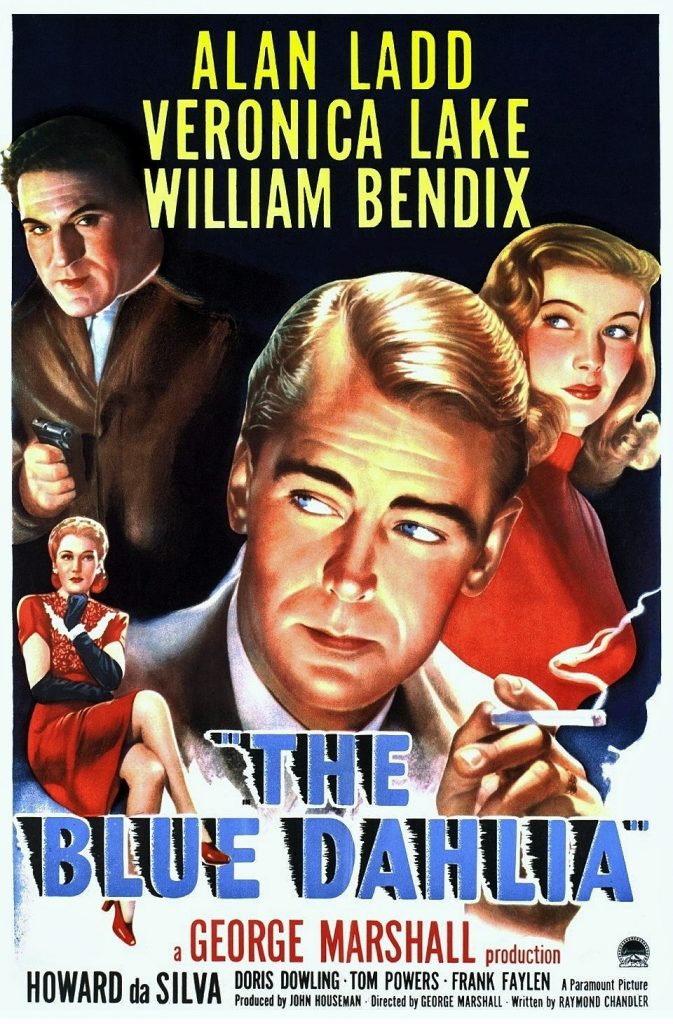
We’ve written about the legend of Chandler writing this screenplay in a previous article. Basically he was more than half in the bag while writing it. It’s also his first original screenplay.
Ladd plays Johnny Morrison who comes home from the war to his wife, Helen (Doris Dowling), in Hollywood. He’s got two navy buddies in tow, George (Hugh Beaumont) and Buzz (William Bendix). Buzz is pretty banged up, he’s shell shocked with a metal plate in his melon.
Johnny finds out that Helen has been two timing him with Eddie (Howard Da Silva), the owner of a nightclub on the Sunset Strip while Johnny was off fighting in the Pacific. But that’s ok because Johnny ends up with Joyce, Eddie’s wife played by Veronica Lake.
What’s not ok is that Johnny also finds out that their son didn’t die of diphtheria like he thought, he died in a car accident where Helen was drunk and behind the wheel. So, later Helen ends up murdered. Which is a shocker because she was so lovely. But Johnny isn’t the only one with a motive for killing his unfaithful wife.
The Killing (1956)

Based on the novel Clean Break by Lionel White, The Killing is great Heist Noir directed by Stanley Kubrick who also co-wrote the screenplay with pulp legend Jim Thompson.
The movie centers around Johnny Clay (Sterling Hayden – the crooked cop in The Godfather), a veteran criminal / Alcatraz graduate planning one last heist. He plans to steal $2 million from a racetrack. The motley team he puts together consists of a corrupt cop, a window teller who works at the racetrack, a wrestler who will pick a fight at the track bar and cause a distraction, said bar’s bartender, and a sniper who will shoot the favorite horse during the race. This is a plan that would make Parker and Danny Ocean blush.
The Big Combo (1955)
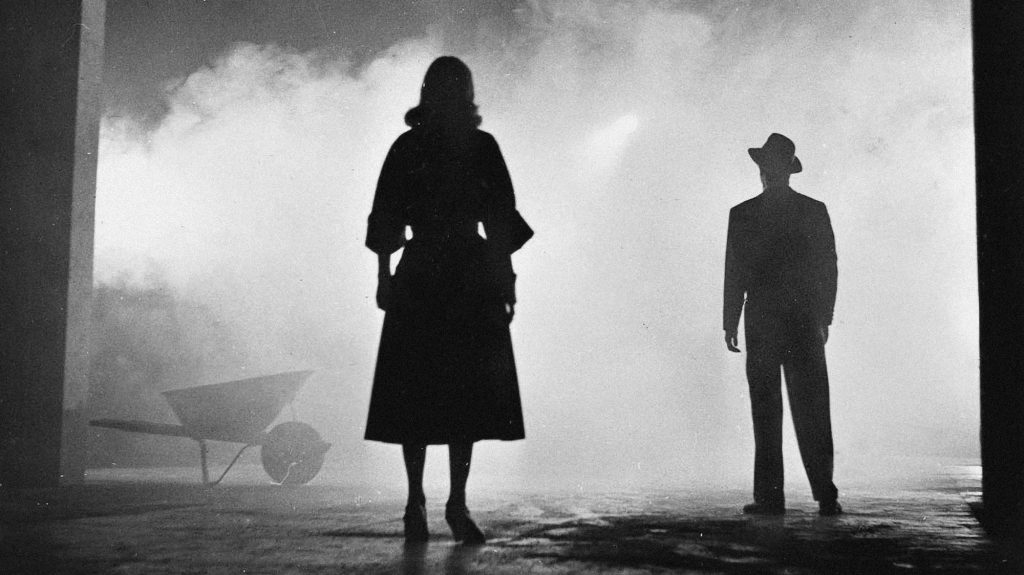
A Film Noir classic, The Big Combo also stars a future Godfather bad guy, Richard Conte. Conte play’s “Mr. Brown” a racketeer in a tug of war with Lieutenant Leonard Diamond (Cornel Wilde) for the heart of Susan Lowell (Jean Wallace). Diamond is also on the case for the disappearance of Mr. Brown’s last girlfriend, Alicia.
Cinematographer John Alton did a beautiful job lighting this thing. But it’s not only the work behind the camera that makes Noir connoisseurs love this movie. The acting is great, especially Richard Conte’s portrayal as Mr. Brown.
The movie was ballsy for the time. Mr. Brown is having an extramarital affair with Susan and there’s allusions to henchmen Fante and Mingo having a homosexual relationship. Fante is played by Lee Van Cleef by the way.
Sunset Boulevard (1950)

When you start your movie with the main protagonist dead in a pool, you’ve got the viewers attention.
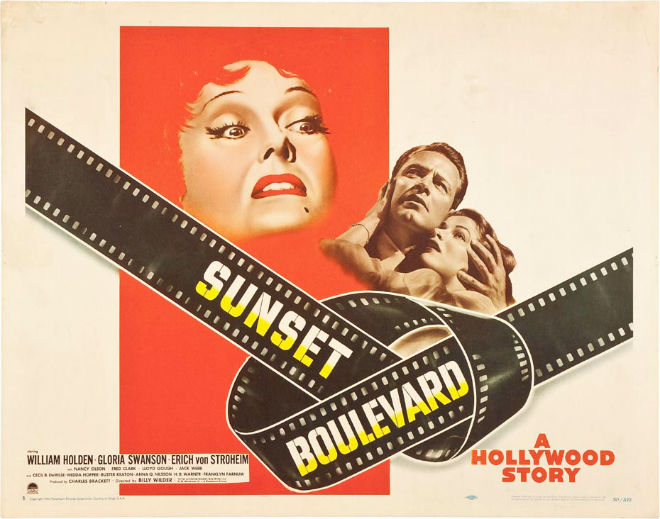
Legend has it that Billy Wilder got the idea to write Sunset Boulevard when he was having dinner at Romanoff’s, a swanky Hollywood restaurant that has since closed. At the table with him was Samuel Goldwyn (the “G” in MGM), Mrs. Goldwyn, and Wilder’s fiancée Audrey Young.
They were having a good time until some drunk, dressed like a hobo walked up to their table reeking of gin. The man in the frayed threads pointed his finger at Goldwyn’s face and said “Here you are, you son of a bitch. I ought to be making pictures.” He was quickly escorted away.
After the piss smelling (I imagine him smelling of piss) man left the restaurant Wilder asked Goldwyn who the hell that was. And Goldwyn told him, D.W. Griffith. Wilder was stunned, Griffith was one of his idols. A couple months later he handed in the script for Sunset Boulevard, a dirge for the fading stars of the silent era.
Speaking of silent stars, the movie has a fun scene where Norma Desmond plays bridge with Buster Keaton, Anna Q. Nilsson, and H.B. Warner (Old Man Gower in It’s a Wonderful Life). Also playing himself is Cecil B. DeMille.
Gloria Swanson plays Norma Desmond, an aging queen of the silent screen. She hires Joe Gillis (William Holden) a young screenwriter and the movie’s narrator to help write her movie comeback. He comes into her life with a flat tire, sees her mausoleum of a home and thinks he can get some money out of her. Boy is he mistaken.
In real life Sunset Boulevard actually was Gloria Swanson’s comeback movie that her character Norma yearned for. But unlike in the movie Swanson had already come to grips with the fact that her career was over. Also, she never killed anyone, at least I don’t think she did.
With her dismissal from Paramount Pictures and rejection from Joe she goes kind of bonkers to say the least. And this was a lady who when “normal” had a funeral for her pet chimp when we first see her.
The Killers (1946)
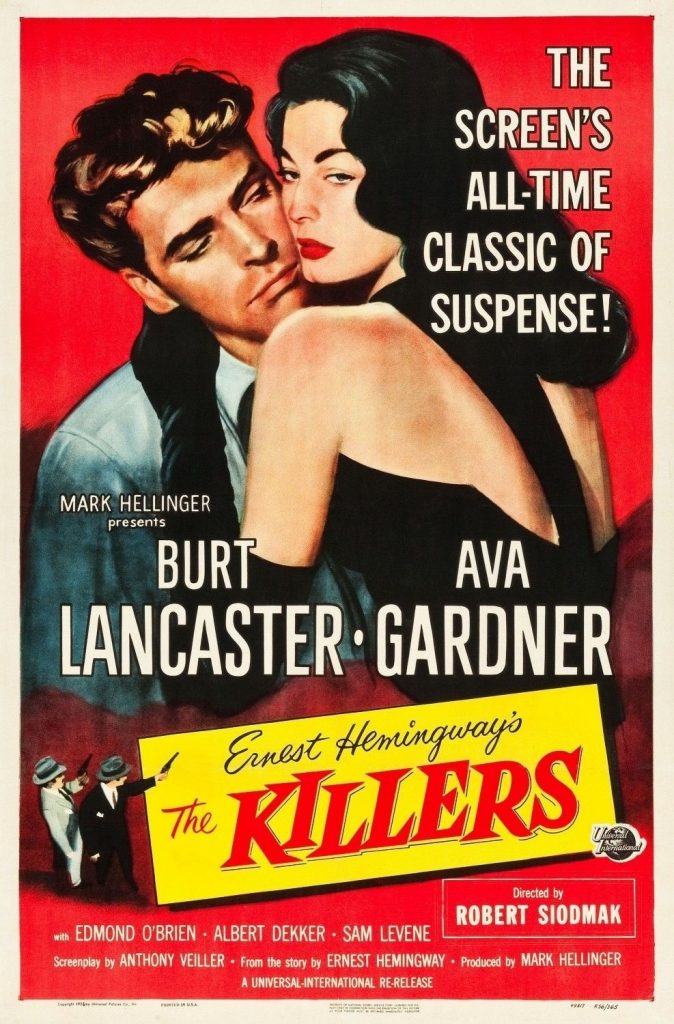
The debut movie for Ava Gardner AND Burt Lancaster this Film Noir was based on Ernest Hemingway’s short story of the same name.
Lancaster plays The Swede. Through a series of flashbacks we find out his name’s Ole Anderson, an ex-boxer with a shattered hand. His friend Lieutenant Sam Lubinsky (Sam Levene) wants him to join the Philadelphia police force. The Swede chooses the exact opposite and starts hanging around some bad eggs. He falls hard for Ava Gardner’s character Kitty Collins. Kitty is the prototypical femme fatale and his decision to go left when he should have gone right proves fatal.

When The Killers was released in New York it was such a smash hit the movie theaters had to stay open 24 hours to meet demand.
Call Northside 777 (1948)

Based on a true story of a Chicago reporter who proved the innocence of a man in prison for murder of a Chicago cop 11 years before. This movie stars Jimmy Stewart as P.J. McNeal a reporter for the Chicago Times. The wrongfully convicted is Frank Wiecek (Richard Conte) a guy who picked the wrong time to go into the wrong speakeasy on the wrong day. And with this being Chicago, corruption and the mafia are abundant.
The Maltese Falcon (1941)
Some consider this the first truly Film Noir movie. There were other’s before it, but this is one of the most famous in the dawn of the Film Noir era that’s for sure.
Based on the novel of the same name by Dashiell Hammett, The Maltese Falcon is what people think of when they think “Film Noir.” A street-wise hardboiled detective in a fedora chain smoking and wise-crackin.

Directed by John Huston who also wrote the screenplay, this movie’s beautifully done and after watching it again, not as confusing as everyone says.
Detective Sam Spade (Humphrey Bogart) takes on a case for the beautiful Ruth Wonderly (Mary Astor). Almost immediately after Spade and his partner Miles Archer take on the case, Archer ends up dead.
Sam then finds himself meeting Joel Cairo (Peter Lorre) who wants help from Sam finding a valuable statuette and offering him $5,000 for the service. Cairo then inexplicably pulls out a gun and Spade knocks him out cold.
Both Wonderly and Cairo are revealed to know each other. Which leaves Spade neck deep in a heap of shit, stuck looking for the bird statue.
Side note: this was the second adaptation of the novel with the first being a lesser known pre-code film ten years earlier.
The Asphalt Jungle (1950)
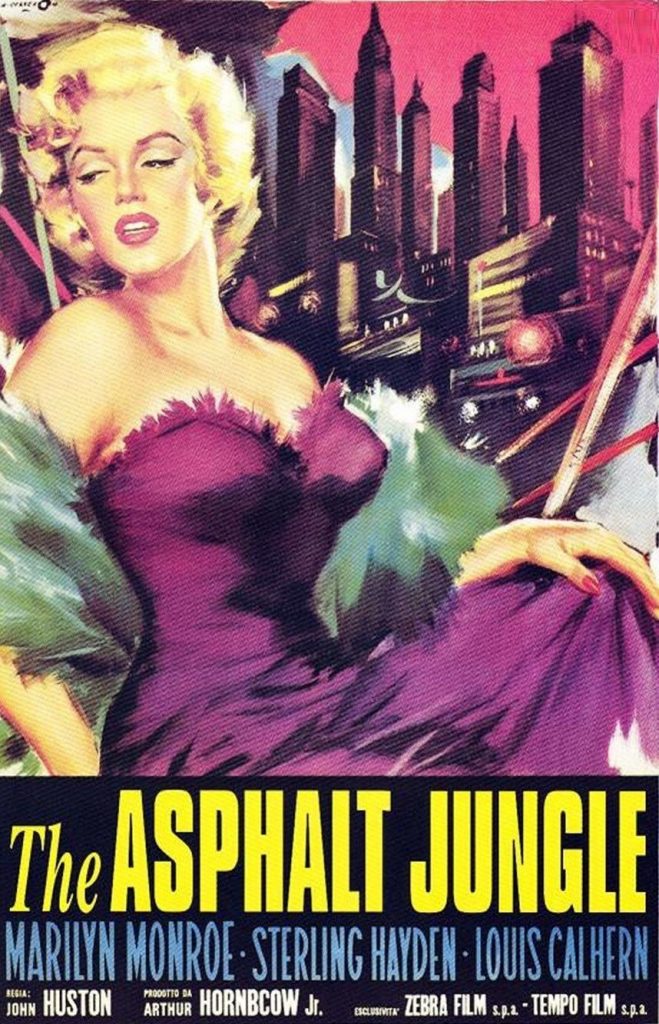
Based on the novel of the same name by W. R. Burnett, it’s another John Huston joint this time with Marilyn Monroe.
Sterling Hayden again plays a recently freed jailbird. This time his names Dix Handley and it’s he who devises a plan to steal $1 million in jewels.
Dix gathers a band of criminals and the heist is a success, but like a Parker novel it doesn’t stay so smooth for long. A stray bullet kills one of the thieves, and after that it’s a domino effect of bad situations. Greed ends up getting in the way as it so often does when you put together a team of untrustworthy criminals.
Double Indemnity (1944)

Based on the James M Cain novel of the same name, Double Indemnity is another great example of the femme fatale in her noir element.
When we first meet Barbara Stanwyck‘s character Phyllis she’s wearing a bath towel. Not long after she’s telling her lover to kill her husband so they can collect insurance money. She is the ultimate femme fatale. . . and a terrible wife.
Walter Neff (Fred MacMurray), a successful insurance salesman, returns to his office sporting a gunshot wound. He begins dictating a confession into a Dictaphone.
He talks about meeting Phyllis Dietrichson (Stanwyck) on a house call to remind her husband (Tom Powers) that his automobile insurance policy is up for renewal. They flirt which naturally leads to her essentially saying she wants to murder her husband and collect the insurance. Neff says he doesn’t want any part of this but hey, this is Barbara Stanwyck! He can’t get her out of his head. She shows up at his apartment and well, he’s in on the plan now. They plan to make it look like an accident so that it will trigger the “double indemnity” clause and pay out twice the policy’s face value. It doesn’t work out.
Out of the Past (1947)
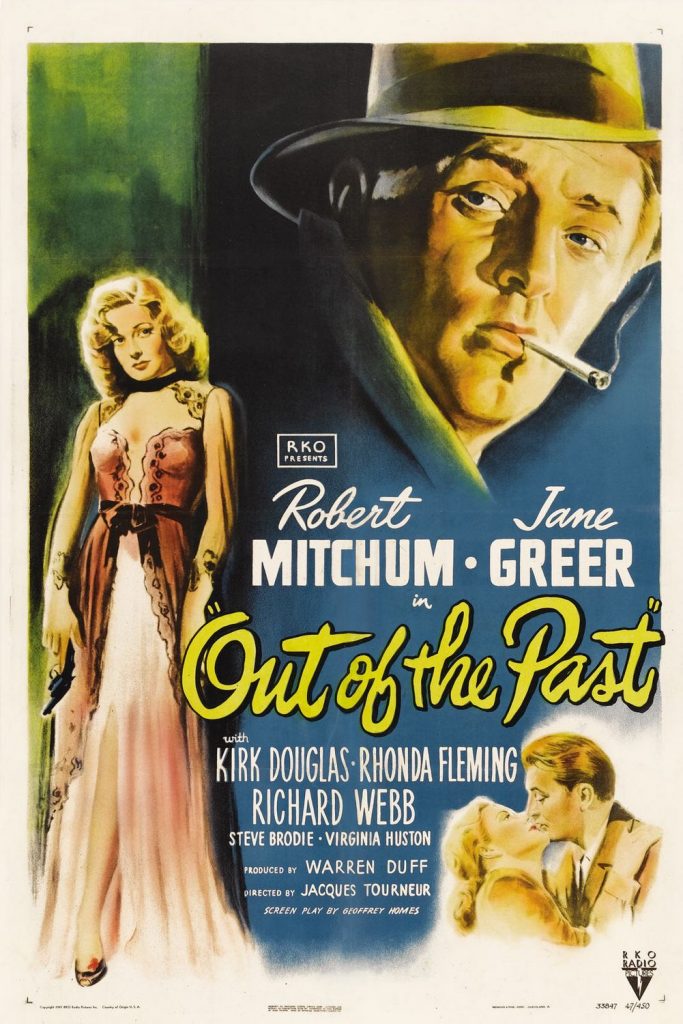
Out of the Past is a classic film noir by RKO starring one of Film Noir’s heavy hitters, Robert Mitchum. Jane Greer plays the femme fatale. She’s great in this, as is a young Kirk Douglas. The screenplay was written by Daniel Mainwaring who adapted it from his own novel and was later blacklisted from Hollywood.
Bob Mitchum plays Jeff Bailey, a gas station owner in a small town with a checkered past. A small-time hood Joe Stephanos (Paul Valentine) gases up and recognizes Bailey. Stephanos’ boss Whit Sterling (Douglas) hired Stephanos to find his girl Kathie (Greer) who shot Whit and stole $40,000 clams.
Laura (1944)
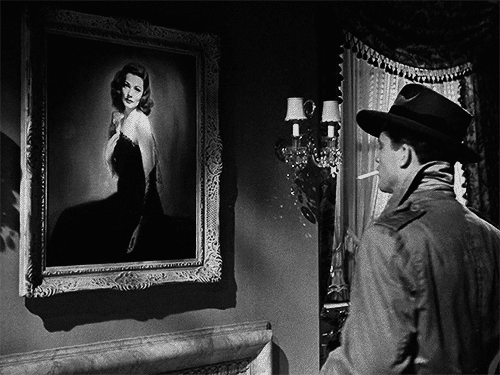
Laura is one of the most celebrated film noirs of all time and with good reason. It’s a classic. It also features a young Vincent Price which is fun.
NYPD detective Mark McPherson (Dana Andrews) investigates the murder of Laura Hunt (Gene Tierney) and eventually finds himself falling in love with a dead woman.
Based on the novel Laura by Vera Caspary this movie’s brilliantly written with a great cast. If you only pick one movie from this list, I might have steer you towards this one. It’s hard, so many of them are great but this is such a good film.
Gilda (1946)
Johnny Farrell (Glenn Ford) is a small-time gambler who get’s caught cheating in blackjack. Instead of getting roughed up, Farrell manages to sweet-talk his way into a job with the casino’s owner, Ballin Mundson (George Macready).
As if the partnership didn’t start off rocky enough, Mundson introduces Farrell to his new wife, Gilda (Rita Hayworth). Gilda is not only the titular character, she’s also Farrell’s ex-lover.
I just want to say, how great a name is “Ballin Mundson?!” That guy was destined to own a Buenos Aires casino.
The Third Man (1948)
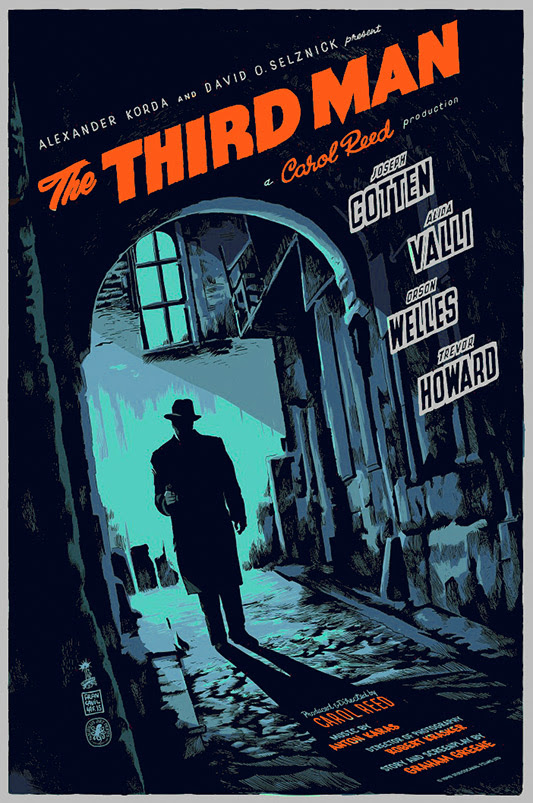
We talked about the masterful cinematography of The Third Man in a few previous articles. It’s great, and it was shot on location in postwar Vienna which gives it a great worn out and war torn vibe.
Starring Joseph Cotten as Holly Martins, a pulp fiction writer who comes to Vienna to visit a childhood friend, Harry Lime (Orson Welles). When he arrives Harry is dead.
Martins starts to investigate Harry’s death after learning of a “third man” present at the time of the murder. Through the course of the investigation he ends up falling head-over-heels for Harry’s lover, Anna (Alida Valli).
The Big Heat (1953)
Gloria Grahame is a fan favorite for the American Pulps team. She was so good in so many Film Noirs. Also, Lee Marvin plays her boyfriend. Power couple.
A police officer has allegedly committed suicide, but Detective Dave Bannion of Kenport PD (Glenn Ford) thinks there’s foul play. After talking to the dearly departed’s mob-connected mistress, Bannion discovers a trail of graft and corruption that leads to the police station. On the other end of that trail is mob boss Mike Lagana (Alexander Scourby).
With the cops as gangster as the gangsters, Bannion quickly finds himself in a bad situation.
The Big Sleep (1946)
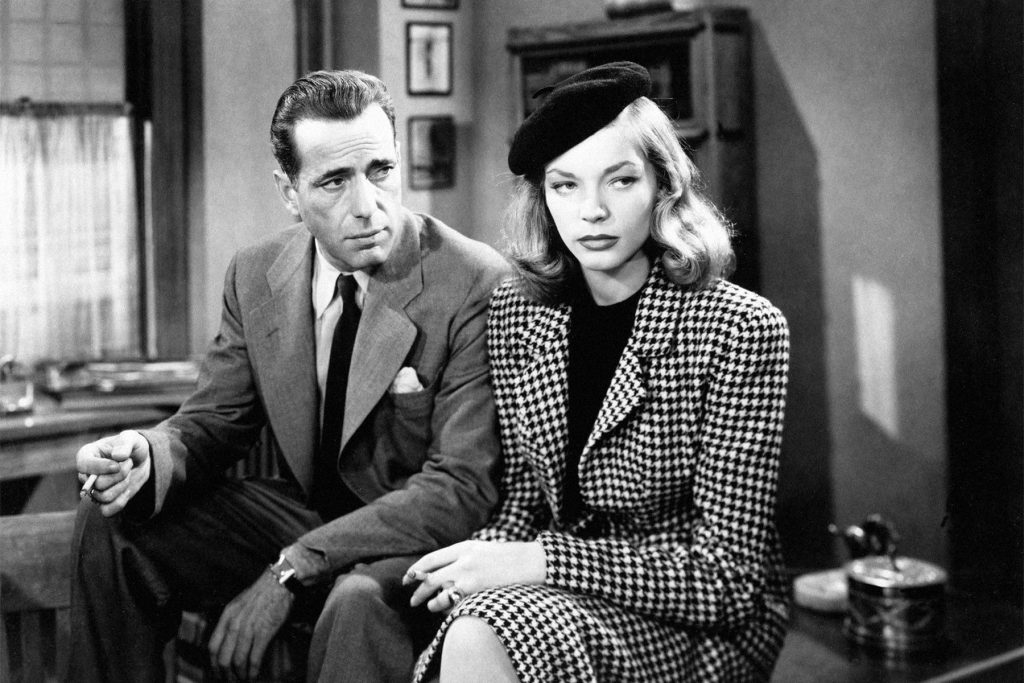
Another noir based on a pulp paperback, this one is the epitomy of Film Noir. With LA based Private Detective Phillip Marlowe (Humphrey Bogart) on the case for a wealthy client, General Sternwood (Charles Waldron). Sternwood wants Marlowe to deal with a bookseller who’s trying to blackmail his wild young daughter, Carmen (Martha Vickers).
Carmen has a habit of getting blackmailed by disreputable men. Sternwood mentions that his other, older daughter Vivian (Lauren Bacall) is in a loveless marriage with a man named Rusty Regan, who has disappeared (this becomes important). There’s a lot of twists and turns and Bogey and Bacall on screen together is a treat.
The Woman in the Window (1944)

Based on the novel Once Off Guard by J. H. Wallis, Fritz Lang had to change the ending up so that it would pass the Production Code of the time. It’s got plenty of twists and turns especially in the third act.
According to Film Noir: An Encyclopedic Reference to the American Style some French dudes coined the phrase Film Noir after watching this film. As Lawrence Bassoff said in his book Crime Scenes “The Woman in the Window is the It’s a Wonderful Life of middle class murder.”
Sweet Smell of Success (1957)
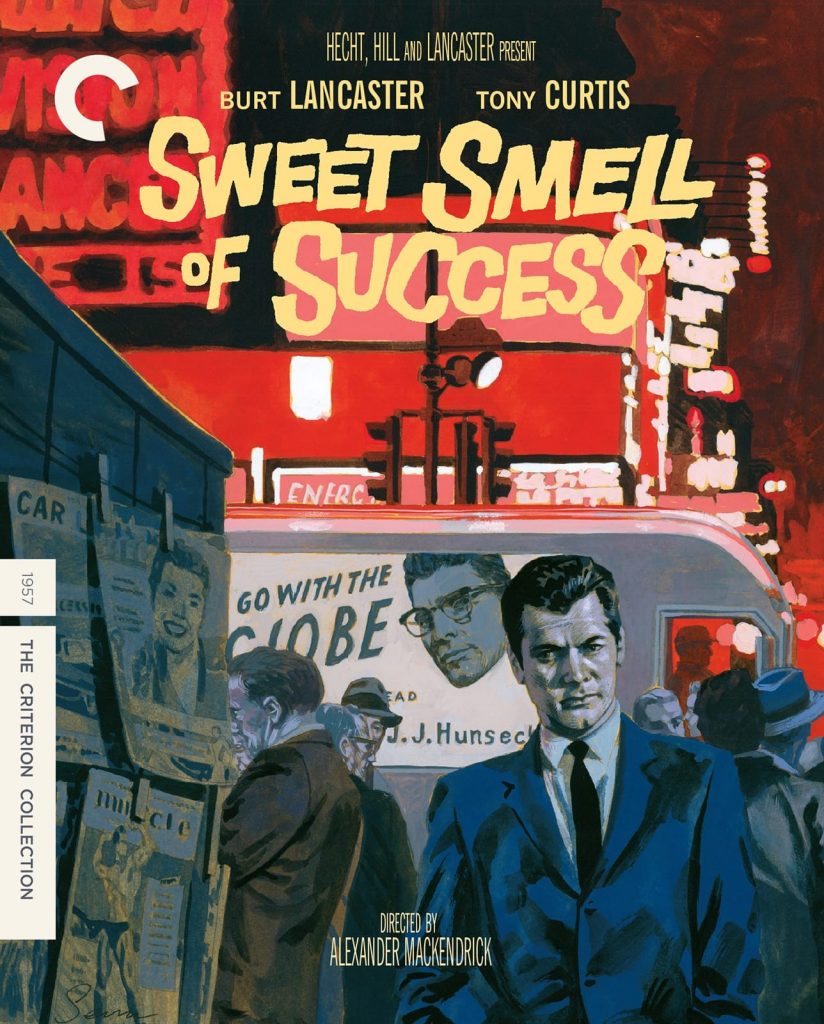
When Sweet Smell of Success first came out it was not with a bang but a wimper. Over the years it’s grown in popularity.
Based on the novelette Sweet Smell of Success by Ernest Lehman, it follows a powerful sleazbag and newspaper columnist J.J. Hunsecker (Burt Lancaster). For the Hunsecker character, Lehman drew inspiration from Walter Winchell. If you don’t know who that is, he was a powerful sleazbag and newspaper columnist. He also had a radio show. Stanley Tucci portrayed him in the HBO biopic Winchell.
Hunsecker uses his power to ruin his sister’s relationship with a man he deems unworthy of her. He taps Sidney Falco (Tony Curtis) to break them up and it doesn’t go smoothly for anyone.
Too Late for Tears (1949)
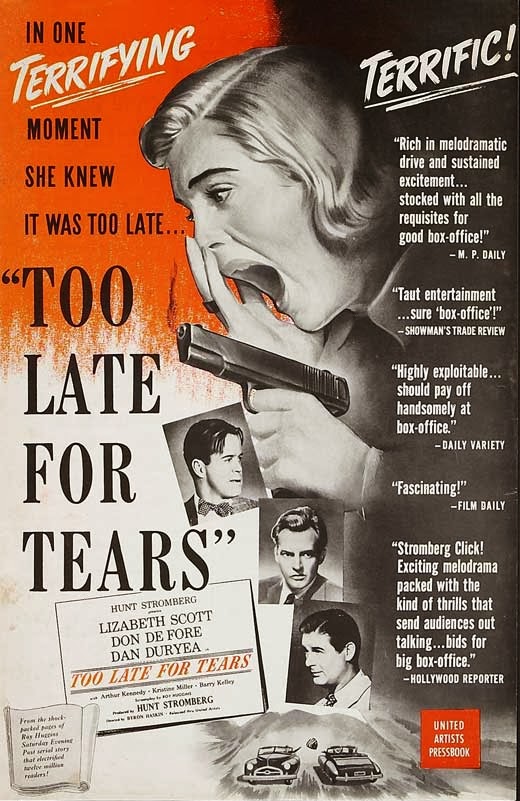
Written by Roy Huggins, who adapted the screenplay from a serial he wrote for the Saturday Evening Post, this one’s a cult classic.
Jane and Alan Palmer (Lizabeth Scott and Arthur Kennedy – born in Worcester, Massachusetts just like yours truly) are driving in the Hollywood Hills on their way to a party when another car chucks a bag of money into their convertible. Which is like a dream come true right? They move into a mansion and take a much needed vacation, perhaps put some money aside for their nest egg right? Nah.
Another car starts following them, the car the bag of money was intended for. They’re able to get away but when they’re back at their Hollywood apartment they fight over whether or not to keep the money. More than their marriage starts falling apart from there.
The Hitch-Hiker (1953)
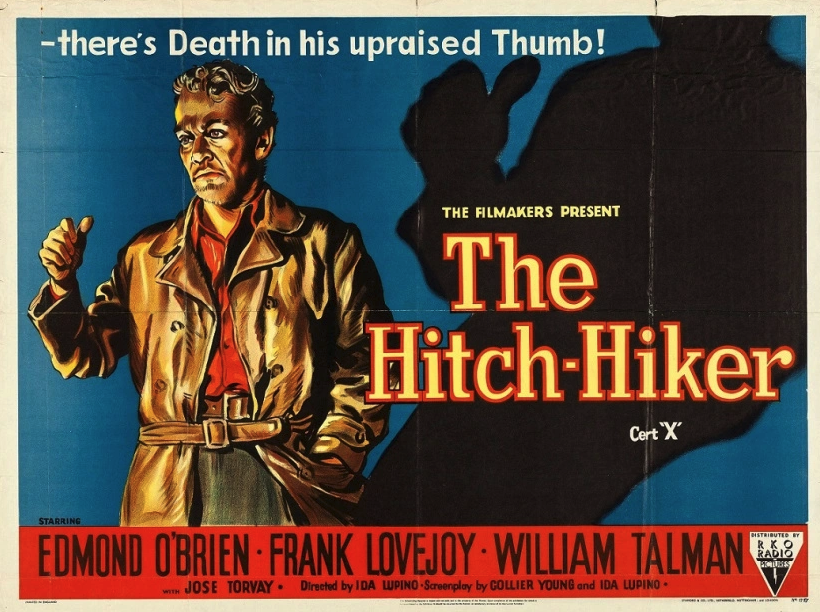
This one’s based on a story by blacklisted Out of the Past screenwriter Daniel Mainwaring. Mainwaring didn’t get any credit for this because someone told the House Un-American Activities Committee that he may have had communist leanings and was subsequently blacklisted.
Mainwaring’s story was based on a real life crime spree of Billy Cook who killed six people on a 22 day rampage. In the movie we follow two guys who pick up a hitchhiker on a fishing trip to Mexico. And as the poster above says, the man they pick up has more death in his thumb than most people have in their whole body.
This of course reminds me of this Bud Light commercial, which is still a classic.
The Stranger (1946)

Do you want to see Orson Welles play a Nazi in hiding? Then this is your flick. Edward G. Robinson plays a war crimes investigator who tracks Franz Kindler (Welles) down in a small town in Connecticut. This is Welles’ third film as director and his first film noir.
Kiss Me Deadly (1955)

Fans of Quentin Tarantino’s Pulp Fiction may notice the glowing briefcase. Also, that video is kind of a mastorbatory soliloquy about Tarantino’s writing. But, fun fact: Roger Avary co-wrote that movie and never got a writing credit. Other films with glowing MaGuffin’s paying homage to this Robert Aldrich classic: Repo Man, Ronin, Raiders of the Lost Ark.
The movie’s based on the novel of the same name by pulp writer Mickey Spillane featuring private detective Mike Hammer. But Aldrich made some changes and created this classic Film Noir with a touch of science fiction.
The Lady from Shanghai (1947)
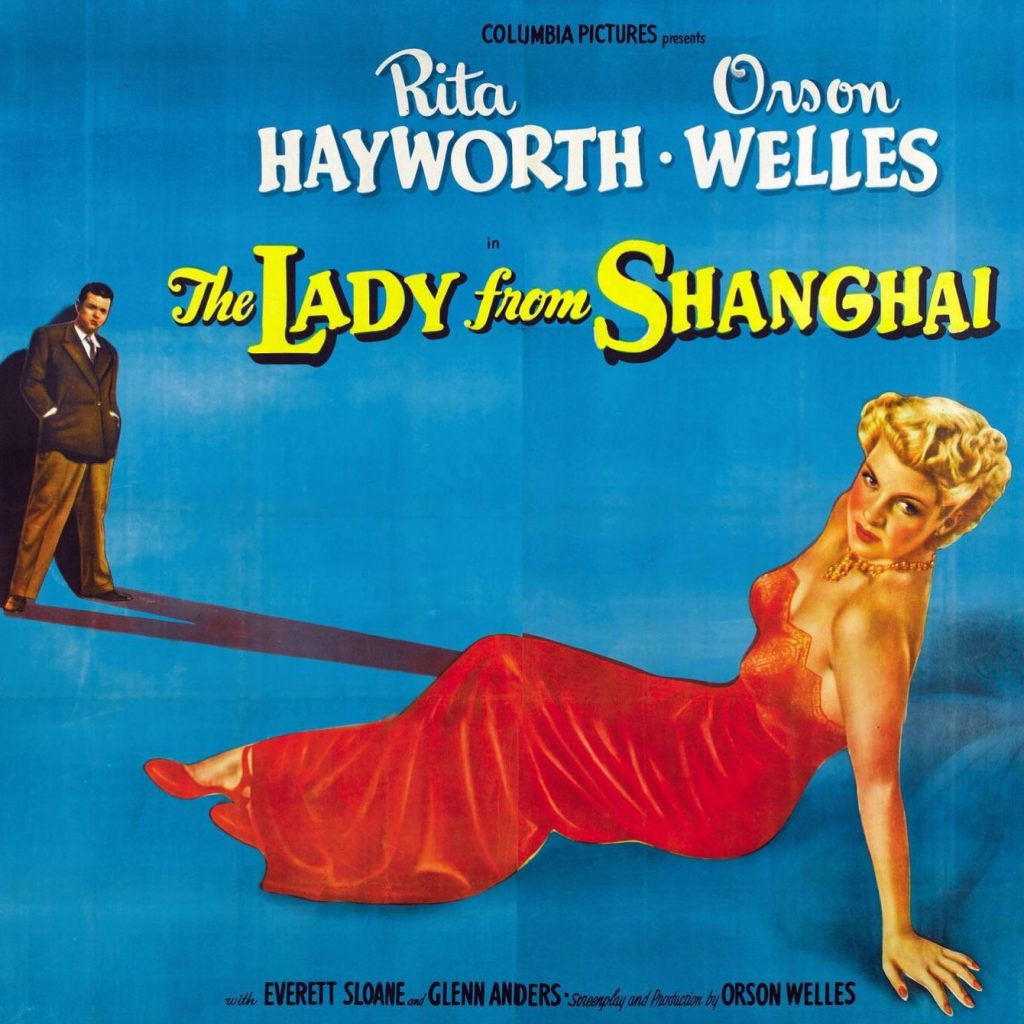
Based on the novel If I Die Before I Wake by Sherwood King, Orson Welles cast his soon to be ex-wife Rita Hayworth as the femme fatale. The two were divorced before the films premier.
The President of Columbia Pictures, Harry Cohn hated the rough cut Orson delievered. And I don’t know if his notes sucked and Welles would have delivered a better movie with no mobbed up Hollywood executive (that’s a future article) asking for “more close ups” but this is my least favorite of the Welles noirs. It’s good and worth a watch but watch the others on this list if you need to pick one.
I will say, the mirror scene at the end is awesome and it was definitely an influence on Enter the Dragon with Bruce Lee.
The Postman Always Rings Twice (1946)
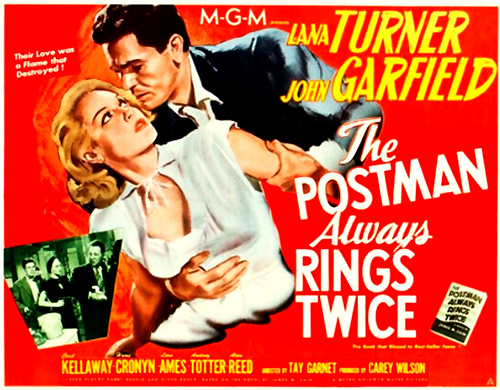
Based on the novel of the same name by James M Cain, this film features Lana Turner as the femme fatale. Lana was a real life femme fatale who dated Johnny Stompanato and had seven husbands. Johnny Stomp was an enforcer for LA Mob boss Mickey Cohen. Stompanato was also murdered by Turners daughter, Cheryl Crane when crane was 14 years old.
This one’s a lot like the other James M Cain adapted noir on the list, Double Indemnity. With a wife and her lover conspiring to kill her husband for money. I guess Cain pulled some inspiration from those four marriages of his.
In a Lonely Place (1950)
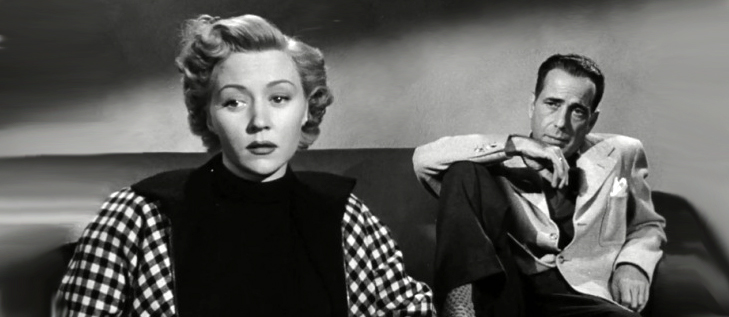
You really can’t beat a movie with Nicholas Ray directing and Bogart and Gloria Grahame sharing screen time. Bogart plays a hotheaded screenwriter. And when I say hothead, I mean he may have flown off the handle and possibly committed a murder.
Criss Cross (1949)
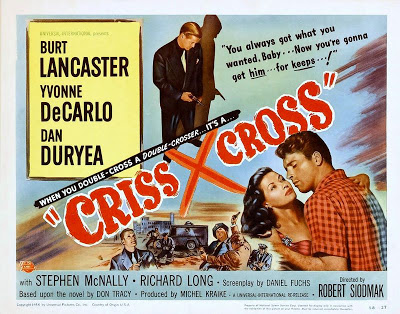
Starring Burt Lancaster and a young Lily Munster (Yvonne DeCarlo) as the femme fatale. Steve Thompson (Lancaster) moves back to Los Angeles and rekindles his relationship with his ex-wife Anna (DeCarlo). Which is kind of sweet but it’s also very dumb because she is now married. To a mob boss. Named Slim Dundee (Dan Duryea). Trouble clearly ensues.
Scarlet Street (1945)
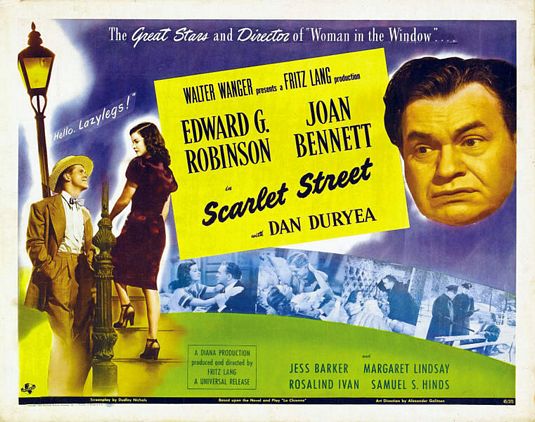
Directed by Fritz Lang, Scarlet Street is one of his many great noirs. Edward G. Robinson plays as a pushover instead of his normal gangster role. This movies great, and watching it you’ll realize how much of a master Fritz Lang was behind the camera.
Gun Crazy (1950)
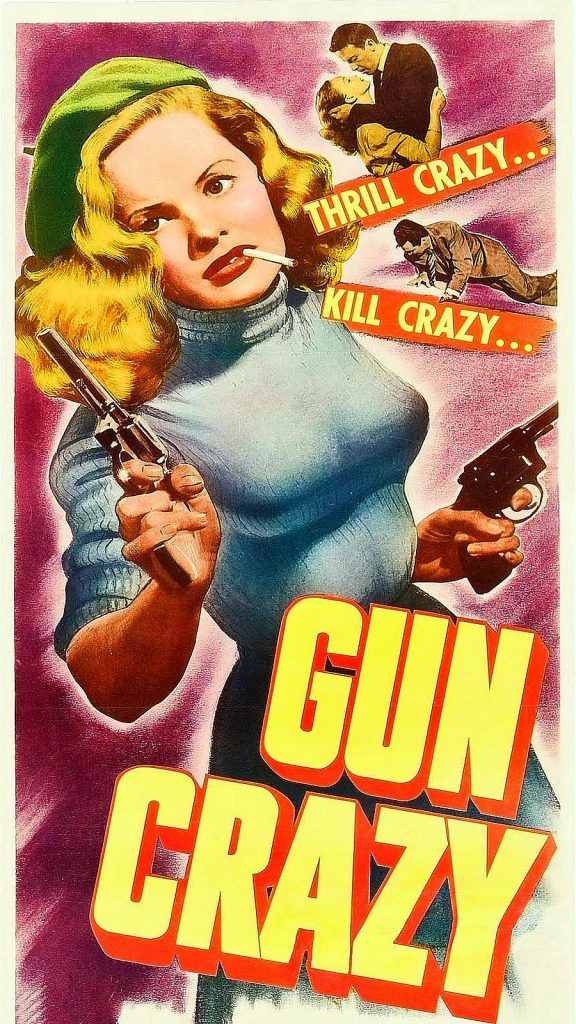
Written by blacklisted writer Dalton Trumbo, who didn’t get a writing credit. The script was based on a short story from The Saturday Evening Post by MacKinlay Kantor.
It’s a Bonnie and Clyde style romance between two gun nuts. Peggy Cummins plays Annie Laurie Starr, a sharpshooter who tells Bart Tare (John Dall) right before their wedding that she’s “bad, but will try to be good.” I think you know where this is going.
They embark on a life of crime and eventually plan “one last robbery” that get’s all shot to hell.

Strangers on a Train (1951)

Based on Strangers on a Train by Patricia Highsmith. A film noir from the master of suspense Alfred Hitchcock with a screenplay by pulp legend Raymond Chandler is worth the price of admission right there.
The movie is about two strangers who meet. . . on a train. One of the strangers is a tennis player, Guy Haines (Farley Granger), the other is a a psychopath Bruno Antony (Robert Walker). They do what strangers do when passing time on a train, talk about the people they want to kill. That’s when the psychopath has an idea. And that idea is kind of psychotic.
Dark Passage (1947)

Based on a story of the same name by David Goodis. It’s also the third of four films Bogey and Bacall did together. The last one, Key Largo (1948) is not on this list but it’s another film noir worth viewing.
Dark Passage has a cool first act or so where it’s shot from Bogart’s POV. Bogart breaks out of the clink, wanting to clear his name because he’s innocent. Much like the Parker novel, The Man with the Getaway Face, or John Dillinger in real life. Bogarts character get’s plastic surgery while on the lam.
The Naked City (1948)
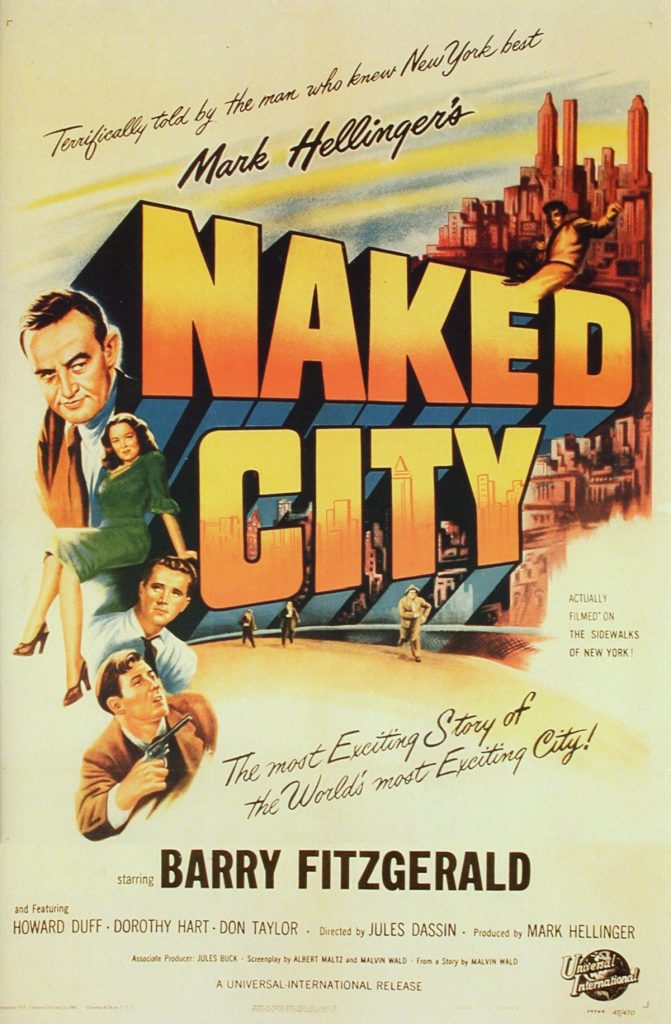
This classic was shot on location in New York City and the city itself is a character throughout the film. The writing from blacklisted writer Jules Dassin is only ok. But, the way it’s shot makes up for any blemishes in the script. The Naked City is one of the earliest police procedurals and was later copied by countless movies and TV shows like Dragnet, Law and Order, Homicide: Life on the Street, Miami Vice, Kojak, etc. etc.
Pickup on South Street (1953)
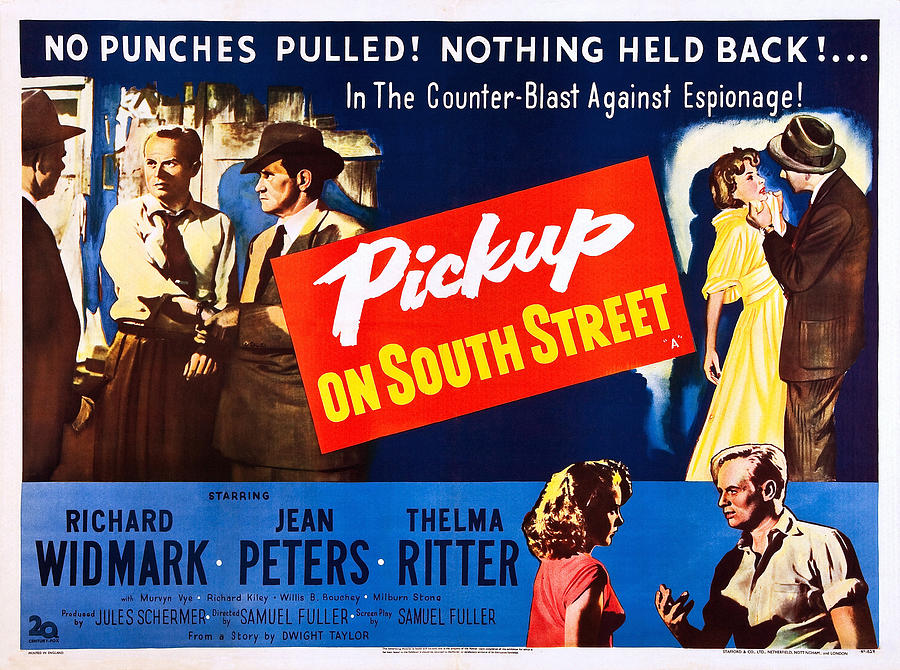
Skip McCoy (Richard Widmark) is a professional pickpocket who’s already been the guest of the government a few times. Skip quickly goes back to his old ways and robs Candy (Jean Peters) on the subway. Unfortunately, Candy is a courier for a deal her ex-boyfriend Joey put together and he robbed the package. Ladies, don’t be a mule for your ex-boyfriends. Let this movie serve as a lesson.
Neither Skip nor Candy are aware that she’s delivering the patent for a deadly chemical, stolen from the US Government by Soviet spies. Now both of them have Johnny Law and the KGB on their heels.
The Wrong Man (1956)
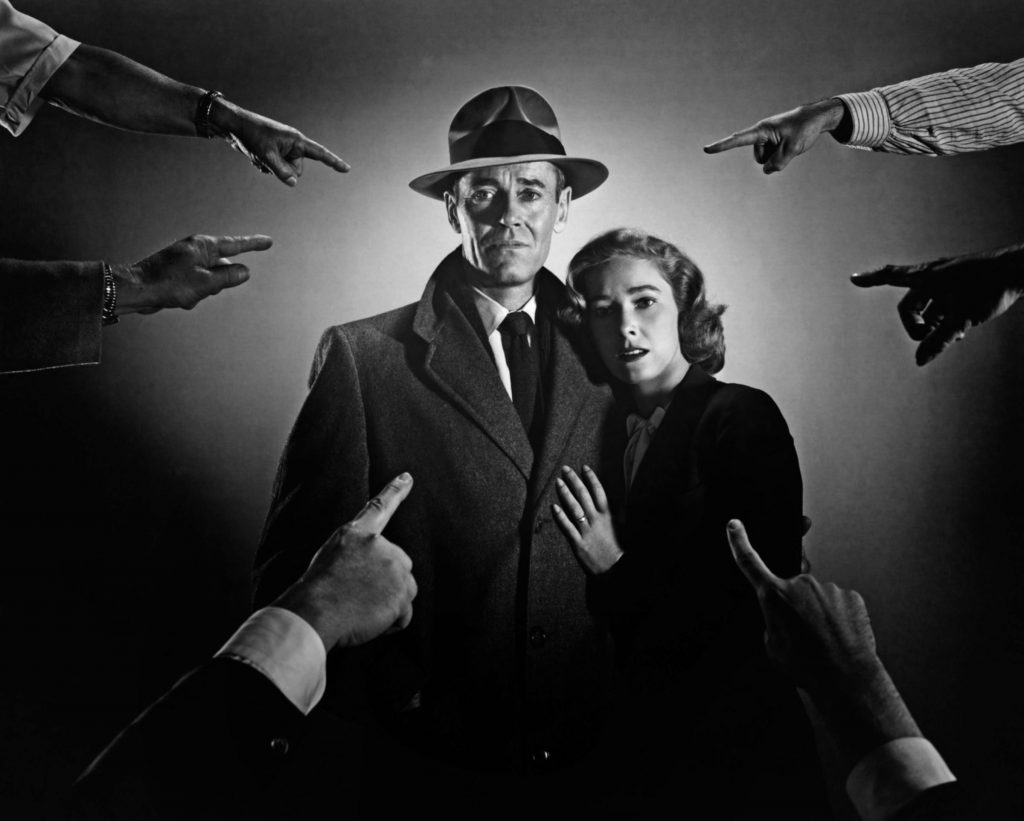
Cited as an influence on Martin Scorsese’s Taxi Driver, this Alfred Hitchcock docudrama is based on real life events. The screenplay was adapted from The True Story of Christopher Emmanuel Balestrero by Maxwell Anderson. As well as a Life magazine article, June 29, 1953 article A Case of Identity by Herbert Brean.
Henry Fonda plays Manny Balestrero, a down on his luck musician at the famous Stork Club who goes to his life insurance company to take out a policy so he can get funds for his wife’s dental surgery. He walks in the door and the guy at the counter confuses him with a guy who robbed the place a couple times.
Night of the Hunter (1955)
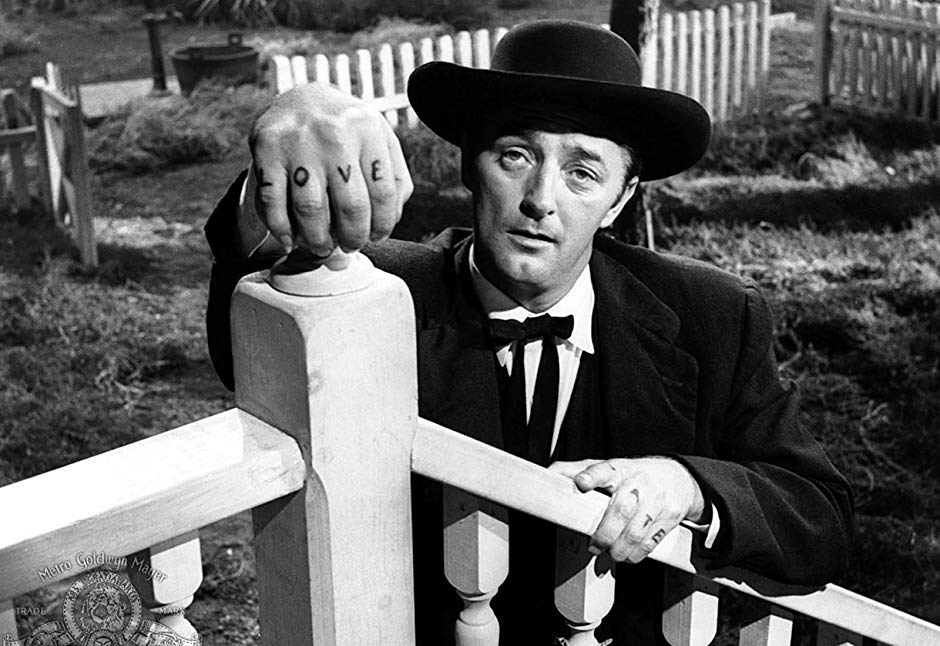
Based on novel of the same title by Davis Grubb. Robert Mitchum plays a corrupt minister-turned-serial killer. I’m listening. Who tries to charm the pants off a widow and steal the $10,000 her husband stashed away. Sold.
Bob Mitchum is such a good bad guy, this is really worth a viewing.
Touch of Evil (1958)

Charlton Heston playing a Mexican and the whole marijuana subplot that reminds me of Reefer Madness aside, this is a great movie. Sadly. It didn’t do well in the box office and kind of marks the end of Orson Welles’ career as well as the end of the Film Noir era.
This opening oner is often shown in film school and really well done, aside from Heston’s cheesedick line. It’s not the best long take but it’s a pretty solid opening to a movie.
Lady in the Lake (1947)

We mentioned The Lady in the Lake in an article about Christmas movies last year. And like we said then, the Raymond Chandler novel it’s based on takes place in the summer. But in the movie they chose to make it Christmastime to juxtapose the dark parts of the story with cheerful Christmas themes.
The whole movie is in Philip Marlowe’s POV. I liked the way they did it in Dark Passage better, where it wasn’t the whole movie. Here’s an example with a conversation between Marlowe and Adrienne Fromsett (Audrey Totter) a shiesty pulp paperback publisher.
As you can see it feels a little long when they’re talking for a while. Seeing Marlowe talk as well as a reaction shot from him here and there would be nice.

Anyway if you stuck around this long I have to thank you. This was one of the longest articles we’ve written.




